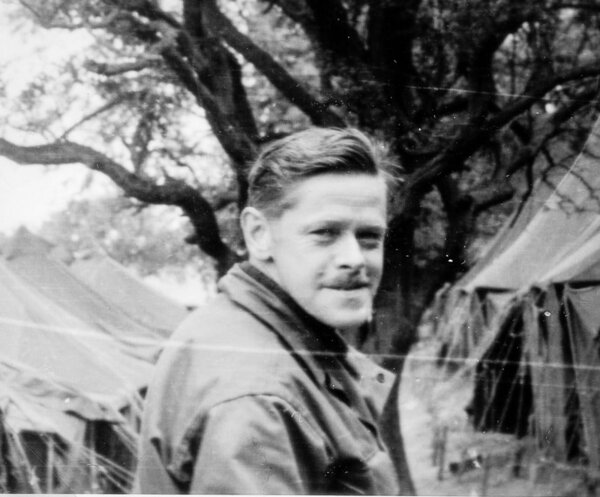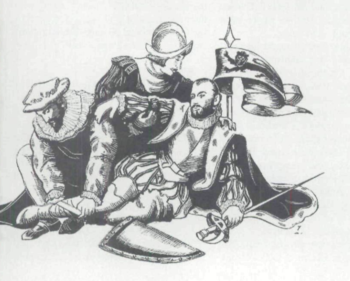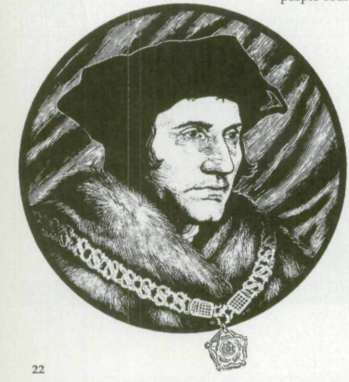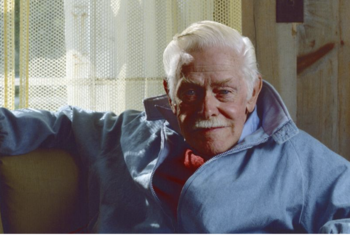John Bertrand Hapgood

PFC in 603rd Engineer Camouflage Bn : Co C
ASN#32349116
Born 1905 in MA, Died 1995
Artist
County of residence at enlistment: Norfolk County, MA
Other residence(s): Worcester, MA; Rochester, NY; New York, NY; Block Island, RI
United States Army, European Theatre of Operations
Occupation before the war: artists, sculptors, and teachers of art
College education before the war: Rochester Institute of Technology
John Hapgood was born on May 14, 1905 in Worcester MA. He was an only child of a baseball maven—Walter E. Hapgood. Walter had started his career as a sportswriter with the Worcester Spy, and then moved on to the Boston Herald and later the Transcript, where he served as sports editor. In 1921 he became business manager for the Boston Braves, working alongside George Stallings who managed the team on the field. In 1921 they bought the Rochester Baseball Club, splitting the work between them the same way. In 1926, Walter became business manager of the Montreal Royals.
John grew up in Massachusetts and later in Rochester, NY, and, not surprisingly, loved baseball. He graduated from East High School in Rochester in 1923 and from the Rochester Institute of Technology in 1926 with a degree in illustration. While in college he was a member of the Art League and the senior class rep to the Student Council; the 1926 yearbook also includes two of his poems.
When his mother died, in 1928, he had been working as an artist with a Rochester ad agency and living with his mother in Rochester, while his father commuted back and forth to Montreal.
In the 1930s he was introduced to Block Island (off the coast of RI) by Charlie Martin, a longtime friend, whose wife Edith (a childhood friend of John's) had spent substantial time there in childhood.
In 1938 he moved to New York where he got a room at the Shelton Hotel* and continued to work as an artist—primarily in pen and ink. He did illustrations for the New Yorker and ads for Bloomingdale's and Lord & Taylor. His work was so intricate that he used a magnifying glass when adding detail to his drawings.
His friends recall him living upstairs from Bernard Baruch and going to the movies with Katharine Hepburn who lived less than two blocks away.
When he registered for the draft, on October 16, 1940, he was living at the Shelton and working as an artist.
He enlisted on June 6, 1942. Like many other artists, especially those from New York, he found himself in the 603rd Engineer Camouflage Battalion of the Ghost Army. And, like other artists, he did his share of downtime sketching—two of his watercolors are shown in The Ghost Army of World War II.
He continued to correspond with his friend, Charlie Martin, during the war. At some point, Charlie purchased 11 acres of land on Block Island with a derelict house. He wrote to John and said he'd paid $750 for it, and if John wanted it he could have it. John agreed and thus became the owner of an island property that he (who was known to his friends as "Hap") nicknamed "Hap-Hazard House."
After he was discharged from the Army, with the rank of PFC, John returned to his artwork and his residence at the Shelton in New York City. But from the end of the war until the end of his life, he summered at Hap-Hazard.

Illustration courtesy America magazine

Illustration courtesy America magazine
According to a 2014 article in the Block Island Times, "his religious works often centered on the Madonna. In addition, his friends looked forward to his Christmas cards, one of which included his drawing of a young Joseph carving a cradle for his son. Cardinal Cook of New York asked Hapgood to complete a piece of art depicting St. Patrick for the celebration of the saint's birthday at St. Patrick's Cathedral in New York."

Photo courtesy The Block Island App
John died on Block Island on his favorite holiday, July 4, 1995, and is buried at Island Cemetery there, in Charlie and Edith Martin's family plot. His gravestone shows his name in a beautiful, flowing font, and calls attention to his service in the 603rd.
*The Shelton Hotel was built by James Lee, Jacqueline Kennedy Onassis' grandfather, as a residence for 1200 bachelors—though later it started admitting women and children. It was designed by Arthur Loomis Harmon, whose firm designed the Empire State Building. Georgia O'Keeffe and Alfred Stieglitz lived at the Shelton from 1925-1929, and Harry Houdini escaped from a coffin-like box in the hotel's swimming pool in 1926. It later became a Marriott Hotel; the hotel closed in 2020 due to the economic impact of COVID-19, and its future is unknown.
Sources:
1905 birth record
1920 census
1923 high school yearbook (includes photo)
1926 college yearbook (includes photo; see p. 42)
https://www.rit.edu/alumni/DrupalFiles/yearbook/pdfs/1926.pdf
1930 census
1940 census
1940 draft card
1942 enlistment record
1949 article in Rochester Democrat & Chronicle (NY) re his father's obituary with bio information
https://www.newspapers.com/image/135516571/?terms=john%20b%20hapgood&match=1
1950 census
1987 article in New York Times re his donating artwork
https://timesmachine.nytimes.com/timesmachine/1987/12/02/311487.html?pageNumber=40
1995 Social Security death index
1995 Find a Grave record
https://www.findagrave.com/memorial/175309573/john-bertrand-hapgood
2024 article in America about his life and art
https://www.americamagazine.org/arts-culture/2024/06/17/john-hapgood-ghost-army-248161